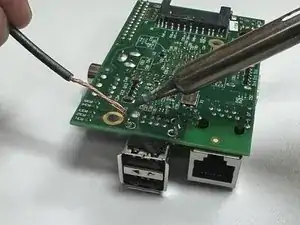
USB Port
Es werden einige allgemeine Werkzeuge verwendet, um an diesem Gerät zu arbeiten. Du wirst nicht jedes Werkzeug für jeden Vorgang benötigen.
The Raspberry Pi Model B was the first single-board computer designed by the UK-based Raspberry Pi Foundation. Released in February 2012, the Model B originally sold for $35 and was replaced by the improved Model B+ in 2014. Although it was intended for use in teaching computer science, the Raspberry Pi is also widely used by hobbyists and researchers.
The Model B has a 700 MHz ARM processor and can be powered via the built-in Micro-USB connector or the GPIO (general purpose input/output) pins. The little machine sports two USB 2.0 ports for a keyboard or mouse, HDMI and composite video outputs, and a 3.5mm headphone jack for audio output. Unlike most newer Raspberry Pi revisions, the Model B includes a full-size SD card reader (instead of microSD).
To identify this device, look at the mounting holes: the original Model B has two mounting holes, while all subsequent models have four holes near the corners. The Model B has two USB ports, whereas the Model A only has one. You can also compare your board to these simple diagrams for each revision.
Processor
Memory
Storage
Video
Connectivity